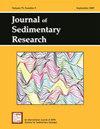一个受季节控制的微潮汐入海口的形态动力学和沉积学:特立尼达岛可可斯湾的纳里瓦河潮汐入海口
IF 2.1
4区 地球科学
Q1 GEOLOGY
引用次数: 0
摘要
该研究分析了纳里瓦河入潮口综合体的地貌和沉积物学,这是一个受潮汐影响的微潮汐入潮口综合体。该综合体由一个后弯的海湾、一个退潮河道和一个退潮三角洲组成。研究人员从 2003 年至 2019 年拍摄的谷歌地球™延时卫星图像中观察并记录了入海口综合体时空演变的形态趋势。通过六个浅层沉积岩芯观察和记录了入海口复合体的二维内部结构以及退潮吐口、退潮吐口、(退潮三角洲的)冲刷平台、口条(与雨季以河流为主的入海口复合体侵蚀有关)、退潮河道和邻近前滩的沉积演替。纳里瓦河入海口宽度随季节变化从 17 米到 40 米不等,潮汐棱镜面积为 2.17 × 105 立方米,横截面积为 29.52 平方米,深度为 1.4 米(按入海口喉部附近旱季高峰期计算)。入海口综合体每年都会发生地貌演变,这与季节性引起的河道向海洋过渡带(FMTZ)的迁移有关。在雨季和飓风季节,河道排水量增加,导致 FMTZ 向流域内迁移,使入海口以河流为主,从而造成入海口群的侵蚀。在旱季,河道排水量低、潮汐占主导地位以及天气晴朗的条件促进了入海口的沉积和入海口复合体的重新发展。入海口具有复杂(CX)的内部结构(填充模式),由其上漂缘横向移动的下弯吐口和退潮吐口以及其下漂缘(如口栅、冲刷平台和前滩)的顺应性丘状要素所界定。退潮-三角洲沉积形成了两种沉积演替:退潮河道轴外演替和轴内演替。轴线外沉积演替与相邻的前滩至海岸面沉积演替十分相似,这给在岩石记录中识别这些沉积物带来了挑战。然而,轴向演替尽管厚度不一,但与所研究的潮间带潮汐为主的入海口演替呈正相关。本文章由计算机程序翻译,如有差异,请以英文原文为准。
THE MORPHODYNAMICS AND SEDIMENTOLOGY OF A SEASONALLY CONTROLLED MICROTIDAL TIDAL INLET: THE NARIVA RIVER TIDAL INLET, COCOS BAY, TRINIDAD
The geomorphology and sedimentology of the Nariva River tidal-inlet complex, a microtidal fluvially influenced tidal-inlet complex, was analyzed. The complex comprises a recurved spit, an ebb-tidal channel, and an ebb-tidal delta. Morphological trends in the spatio-temporal evolution of the inlet complex were observed and recorded from Google Earth™ timelapse satellite images taken from 2003 to 2019. The two-dimensional internal architecture of the inlet complex and the sedimentary succession of the recurved spit, an ebb spit, the swash platform (of the ebb-tidal delta), a mouth bar (associated with the wet-season river-dominated inlet complex erosion), the ebb-tidal channel, and the adjacent foreshore were observed and documented from six shallow sedimentary cores.The Nariva River inlet width ranges from 17 to 40 m through its seasonal evolution, has a tidal prism of ∼ 2.17 × 105 m3, a cross-sectional area of 29.52 m2, and a depth ∼ 1.4 m (calculated at peak dry season near the inlet throat). The inlet complex undergoes an annual geomorphological evolution linked to the seasonally induced migration of the fluvial-to-marine transition zone (FMTZ). Increased fluvial discharge during the wet and hurricane seasons results in the basinward migration of the FMTZ rendering the inlet river dominated and resulting in the erosion of the inlet complex. During the dry season, low fluvial discharge, tidal dominance, and fair-weather conditions promote sedimentation in the inlet and the redevelopment of the inlet complex. The inlet has a complex (CX) internal architecture (fill pattern) defined by the laterally migrating recurved spit and ebb spit on their updrift margin, and conformable, mounded elements on their downdrift (e.g., mouth bar, swash platform, and foreshore). Two sedimentary successions were developed for ebb-tidal-delta deposits: off-axis of the ebb-tidal channel and on-axis. The off-axis succession is considerably similar to the adjacent foreshore-to-shoreface succession which can pose a challenge when attempting to identify these deposits in the rock record. The on-axis succession, however, despite thickness variability, showed a positive correlation to studied mesotidal tide-dominated inlet successions.
求助全文
通过发布文献求助,成功后即可免费获取论文全文。
去求助
来源期刊
CiteScore
3.80
自引率
5.00%
发文量
50
审稿时长
3 months
期刊介绍:
The journal is broad and international in scope and welcomes contributions that further the fundamental understanding of sedimentary processes, the origin of sedimentary deposits, the workings of sedimentary systems, and the records of earth history contained within sedimentary rocks.

 求助内容:
求助内容: 应助结果提醒方式:
应助结果提醒方式:


